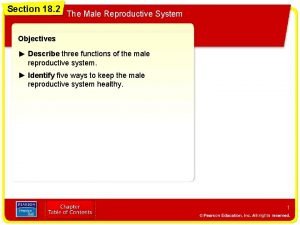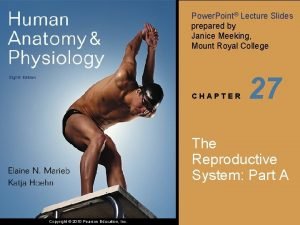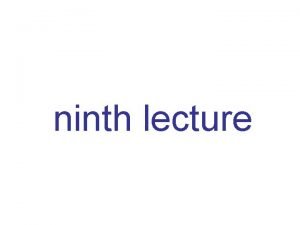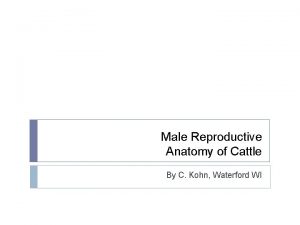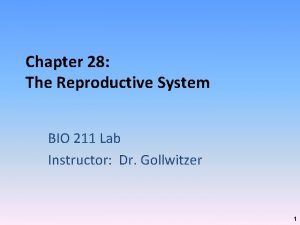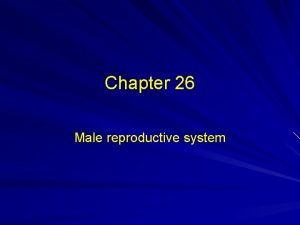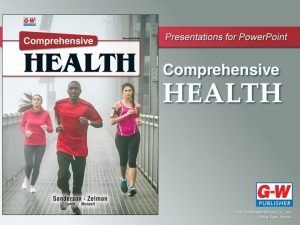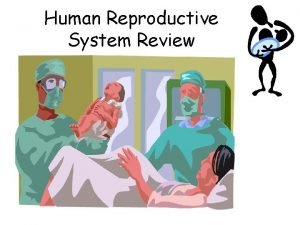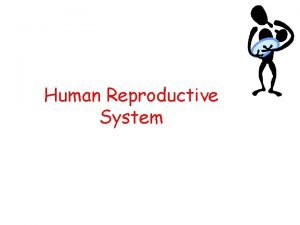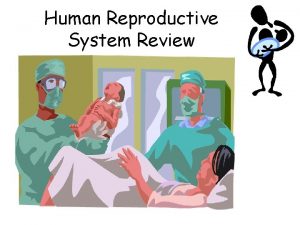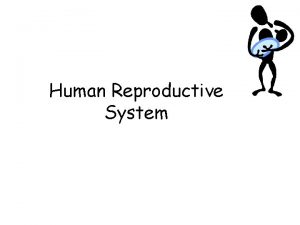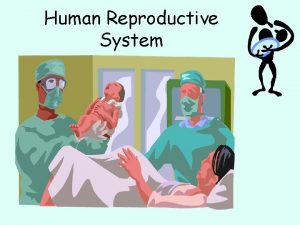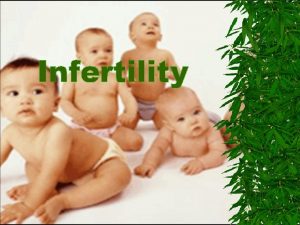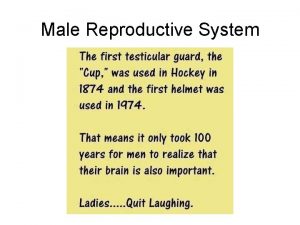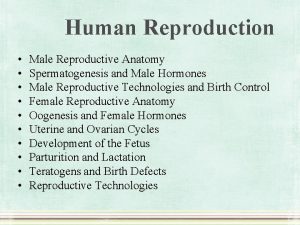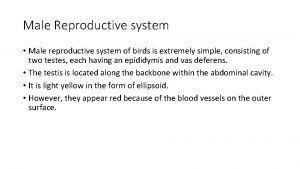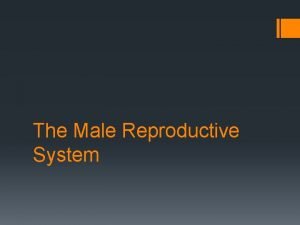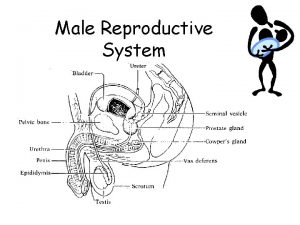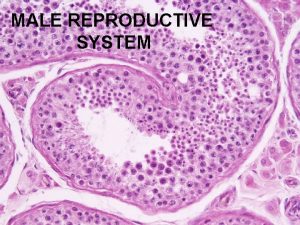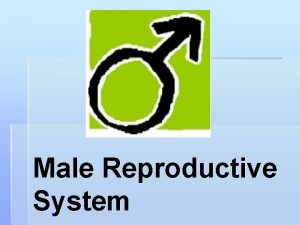Reproductive System Chapter 16 Male Reproduction anatomy sperm



























- Slides: 27

Reproductive System Chapter 16 Male Reproduction anatomy sperm Female Reproduction anatomy ovarian cycle menstrual cycle Copyright © 2009 Pearson Education, Inc.

Male Reproductive System Copyright © 2009 Pearson Education, Inc. Figure 16. 1

Male Reproductive Organs and Glands Copyright © 2009 Pearson Education, Inc. Table 16. 1

Male Reproductive System: Produces and Delivers Sperm § Testes produce sperm § Site: seminiferous tubules § Reproductive tubules: epididymis, ductus (vas) deferens, ejaculatory duct, penis Copyright © 2009 Pearson Education, Inc.

Male Reproductive System: Accessory Glands § Seminal vesicles § Secrete fructose, seminal fluid § Prostate gland § Secretes watery alkaline fluid § Bulbourethral gland § Secretes lubricating mucus § Cleanses urethra Copyright © 2009 Pearson Education, Inc.

Sperm Production § Several cell divisions of mitosis and meiosis § Purpose § Produce a large number of sperm with half the number of chromosomes of somatic cells (haploid) § Sequence § Primary spermatocyte, secondary spermatocyte, spermatids, sperm Copyright © 2009 Pearson Education, Inc.

Blood Testosterone Concentration and Sperm Production Copyright © 2009 Pearson Education, Inc. Figure 16. 3

Regulation of Male Reproductive Activity § Hormones § Testosterone § Source: Leydig cells in seminiferous tubules § Function: controls growth and function of male reproductive tissues, stimulates aggression and sexual behavior, and secondary sexual characteristics Copyright © 2009 Pearson Education, Inc.

Regulation of Male Reproductive Activity § Hormones (continued) § Gonadotropin-releasing Hormone (Gn. RH) § LH stimulates production of testosterone § FSH may enhance sperm formation with Sertoli cells § Inhibin Copyright © 2009 Pearson Education, Inc.

Female Reproductive System Copyright © 2009 Pearson Education, Inc. Figure 16. 4 a

Female Reproductive System Copyright © 2009 Pearson Education, Inc. Table 16. 2

Female Reproductive System: Produces Eggs and Supports Pregnancy § Ovaries § Release oocytes and secrete the hormones estrogen and progesterone § Oviduct (fallopian tube) Copyright © 2009 Pearson Education, Inc.

Female Reproductive System: Produces Eggs and Supports Pregnancy (cont. ) § Uterus: the hollow, pear-shaped organ where fertilized egg grows and develops § Layers § Endometrium: supports fertilized egg, part of it sloughs off during menstrual flow § Myometrium: smooth muscle, expands during pregnancy, constricts during labor § Cervix: the narrow opening in the lower part of the uterus that permits sperm to enter the uterus and allows the fetus to exit during birth Copyright © 2009 Pearson Education, Inc.

Ovarian Cycle Copyright © 2009 Pearson Education, Inc. Figure 16. 6

Menstrual Cycle: Uterine Cycle § Uterine cycle prepares uterus for pregnancy § Menstrual phase § Days 1– 5 § Estrogen and progesterone decrease § Endometrial lining degenerates § Menstruation occurs Copyright © 2009 Pearson Education, Inc.

Menstrual Cycle: Uterine Cycle § Uterine cycle prepares uterus for pregnancy (cont. ) § Proliferative phase § Days 6– 14 § Estrogen and progesterone increase § Endometrial lining proliferates § Ovulation § Day 14 Copyright © 2009 Pearson Education, Inc.

Menstrual Cycle: Uterine Cycle § Uterine cycle prepares uterus for pregnancy (cont. ) § Secretory phase § Days 15– 28 § Corpus luteum produces progesterone and estrogen § Endometrium continues to proliferate § Uterine glands mature Copyright © 2009 Pearson Education, Inc.

Menstrual Cycle Copyright © 2009 Pearson Education, Inc. Figure 16. 7

Regulation of the Menstrual Cycle Copyright © 2009 Pearson Education, Inc. Figure 16. 8

Regulation of Menstrual Cycle § Cycles of hormones of pituitary and reproductive structures § Positive feedback § In proliferative phase, increasing estrogen causes surge in LH § Negative feedback § In secretory phase, steady levels of estrogen and progesterone inhibit LH and FSH release Copyright © 2009 Pearson Education, Inc.

Contraceptive Methods: Failure Rates Copyright © 2009 Pearson Education, Inc. Table 16. 3

Birth Control Methods § Abstinence § Surgical sterilization: vasectomy, tubal ligation § Hormonal methods: pills, injections, patches, rings § IUDs: small plastic or metal piece inserted into uterus § Diaphragms and cervical caps: block the cervix § Chemical spermicides: kill sperm cells PLAY Animation—Ovulation & Hormonal Birth Control Methods Copyright © 2009 Pearson Education, Inc.

Birth Control Methods (cont. ) § Condoms: trap ejaculated sperm § Natural alternatives: rhythm method, withdrawal § Morning-after pills: prevent pregnancy from continuing § Abortion: terminate pregnancy § The future: male birth control pill; vaccines for women Copyright © 2009 Pearson Education, Inc.

Infertility: Inability to Conceive § Many causes of infertility § Number and quality of sperm § Pelvic inflammatory disease (PID) § Endometriosis § Miscarriage Copyright © 2009 Pearson Education, Inc.

Infertility: Inability to Conceive § Enhancing fertility § Artificial insemination § In vitro fertilization § GIFT § ZIFT § Fertility-enhancing drugs § Surrogate mothers Copyright © 2009 Pearson Education, Inc.

Sexually Transmitted Diseases (STDs): Worldwide Problem § Bacterial § Gonorrhea, syphilis, chlamydia § Viral § HIV, hepatitis B, genital herpes, HPV § Other § Yeasts (Candida), protozoan (Trichomonas), arthropod (pubic lice) Copyright © 2009 Pearson Education, Inc.

Sexually Transmitted Diseases (STDs): Worldwide Problem § Prevention strategies § Choose partner wisely § Communicate § Use suitable barriers § Get tested and treated § Get vaccinated Copyright © 2009 Pearson Education, Inc.
 Male reproductive system produces sperm cells
Male reproductive system produces sperm cells Pathway of sperm in male reproductive system
Pathway of sperm in male reproductive system Male prostate
Male prostate Chapter 16 lesson 2 the male reproductive system
Chapter 16 lesson 2 the male reproductive system Why are sperm whales called sperm whales
Why are sperm whales called sperm whales Function of the vagina
Function of the vagina Male function
Male function Development of female reproductive system
Development of female reproductive system Exercise 42 anatomy of the reproductive system
Exercise 42 anatomy of the reproductive system Oogenesis process
Oogenesis process Spermiogenesis
Spermiogenesis Parts of male and female reproductive system
Parts of male and female reproductive system Male reproductive system
Male reproductive system Luteinizing hormone in male reproductive system
Luteinizing hormone in male reproductive system Male reproductive system in plants
Male reproductive system in plants Art-labeling activity: the male reproductive system, part 1
Art-labeling activity: the male reproductive system, part 1 Male reproductive system information
Male reproductive system information Functions of testes
Functions of testes Male reproductive system plants
Male reproductive system plants Function of male reproductive system
Function of male reproductive system Fish reproduction
Fish reproduction Pila fertilization
Pila fertilization Fetal pig female reproductive system
Fetal pig female reproductive system Male plant reproductive system
Male plant reproductive system Figure 28-1 the male reproductive system
Figure 28-1 the male reproductive system Primary sex organ of the male reproductive system? *
Primary sex organ of the male reproductive system? * Lesson 20.2 the male reproductive system
Lesson 20.2 the male reproductive system Horse reproductive system
Horse reproductive system

